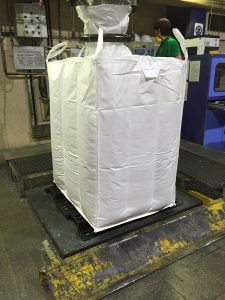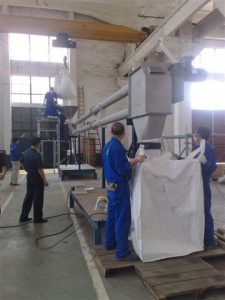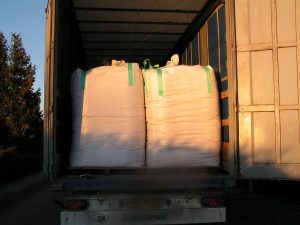Exporting is normally made through long distances. The longer the distance that a product is transported, the higher the cost impact is on what can be considered “dead weight.”
Even when we talk about bulk material handling, we will almost always have to consider the packaging portion of the operation.
Whether it is easy-to-flow or hard-to-flow products, a form of containment and/or protection is almost always needed.

What is bulk packaging?
Packaging is simply described as the process or system of enclosing or protecting products for the next steps in the supply chain – storage or distribution, sale, and final use.
Therefore, packaging:
- Prepares and contains the goods,
- protects them during transportation or in the warehouse,
- preserves (from insects, animal, UV rays, dust, etc.),
- in many cases, can be part of the transport, too,
- can also have other functions as information and, for sure, sales (a goodpackage is a form of advertising what is inside).
By comparison, bulk packaging focuses on the containment and protection of a loose, granulated, or powdered material that will be transported as cargo. This bulk packaging must comply with all related government rules and/or regulations, particularly those related to exportation.
Cost and savings opportunities
Sometimes, packaging can represent a significant portion of a product’s cost. Hence, the smart application of packaging can reduce costs and result in higher profits.
For example, the logistics operation for products like flying ash, wooden chips, and some other low-cost materials represent a higher price in the total cost of the supply chain, being one of the extremes where the supply chain management spends more time trying to save cents per ton. It is a critical factor to reduce the cost of packaging as much as possible in a case like this.
This simple process will impact your supply chain.
Packaging can also save money on labor costs as the right application facilitates the expedited stuffing (loading) operation, the inter-process storage, and transportation to the end user / customer.
At the same time, it ensures safe and secure deliveries that arrive untainted and undamaged, eliminating possible delays.
These aspects of export packaging, show the importance of knowing how to choose the right packaging system and materials and how to define the right mode of transportation in each market.
Consider that the costs of a certain good is given just by the sum of labor and material to make it. Also consider that each bag weights approximately 70 g, so for 520 bags there are 36.4 kg of material plus 520 x 0,6 m (312 m) seam job.
In a big bag, there are approximately 760 g – for 26 bags, there are 20 kg of material with the same 312 m seam job equal to the same volume of material carried in individual 50 kg bags.
In a container bulk liner bag, there are approximately 16 kg with only a 48-m seam job, to do the same job of carrying 26 tons in a 20ft standard ISO container.
By looking at this simple comparison, notice that the cost of the packaging material is a lot less for the container bulk liner than for the other two ways of carrying bulk solids materials.
Nowadays, most companies care about this environmental impact and its costs, even though they tend not to be as relevant as other costs, but it needs to be included in a cost especially because of the containment and transportation packages that are discarded at the end of these processes. Packages that are not biodegradable create higher disposal costs.
A lot less materials are reprocessed or incinerated (depending on what is carried) in a container liner bag than in the other 2 options to package bulk solids, generating a minimal impact on the environment and at a much lower cost.
Costs and the decision matrix
To make a good decision, it is important to be able to thoroughly compare the various options and even validate their performance.
Bulk solid materials can generally be carried in special trucks / ships, in big bags (1 or 2 ton), in individual (25, 50 or 60 kg) bags, or in an ISO container with bulk liner bags.
Notice that there will be a difference in sizes and quantities of packaging materials when you compare the variety of options available to carry bulk solids.
Although there are no packaging materials for special trucks or ships one side, there will be lots of packages and for the big bags a little less.
The same happens with labor. For packing and handling 50 kg bags, there is a much higher labor-intensive process it takes 4 men to carry 520 bags of 50 kg/each in a 20ft container in 2 hours. In contrast, the bulk liner bags or the special trailers for trucks or ships and the big bags require less labor than the regular 50 kg bags.
It only takes approximately 2 men to fill the equivalent number of big bags in 1 hour, but will still use a lot more than the container bulk liner bag or special truck – trailer – ships.
This brings up the question: Is it always possible to stuff a 20ft container with 520 x 50 kg bags? Of course not! So this is another cost factor downgrading the container’s load capacity.
On the other hand, there are at least two problems with the use of the special truck – trailers or ships:
- the “empty return” that has a very high cost compared to the modals where there is a “full return;”
- the high investment in equipment for a very limited use.
The modals that use containers that carry 50 kg bags, big bags, or container bulk liner bags are a lot more flexible, the containers can return full of other materials, and all of this can be done with a much lower investment.
To make things even more clearer, let us look at the following:
- Costs in Packaging material:
- Lowest is using special trucks / trailers / ships – no material
- Second lowest is Container Bulk Liner Bag
- Third lowest is the use of big bags
- The worst cost is individual bags (25, 50 or 60 kg)
- Labor costs:
- Lowest costs are special trucks / trailers / ships at the same time as Containers with bulk liner bags, that have very similar labor costs.
- Second lowest cost is big bags
- Worst cost is individual bags (25, 50 or 60 kg)
- Equipment Investment:
- Lowest is using special trucks / trailers / ships – no material
- Second lowest is Container Bulk Liner Bag
- Third lowest is the use of big bags
- The worst cost is individual bags (25, 50 or 60 kg)
- Cost of equipment back trip:
- Lowest cost is using container bulk liner bags, individual bags (25, 50 or 60 kg) and big bags into containers once the containers can always return stuffed with other materials.
- Worst cost is the use of special trucks / trailers / ships that are dedicated to that material and have to return empty, so limiting the maximum distance x total load carried to become minimally viable.
- Environmental Costs:
- Lowest would be the use special trucks / trailers / ships once there is no packaging involved.
- Second lowest is the use of bulk container liner bags for the simple reason that it uses a lot less material to be discarded / reprocessed
- Third lowest, following the same line, is the use of big bags
- Worst cost will be the use of individual bags.
Best cost-saving option to transport solid bulk cargo through long distances?
A company can reduce the total cost-impact of packaging in any operation by:
- Minimizing costs in packaging material and labor
- Minimizing costs in equipment investment and reducing the cost of return of the equipment
- Minimize the environmental costs
Bulk-Flow offers a variety of options that meet these qualifications.
The solution
Bulk Container Liner Bags! Expedite operations with hard-to-flow bulk solids even more, with fluidizing liner.
Want more?, Get answers!
Contact us!
We are eager and pleased to help you improve your logistics process methods and create a much more efficient supply chain, generating profits to your company.
Feel free to call us for a consultation on how to best transport your bulk solids materials.




